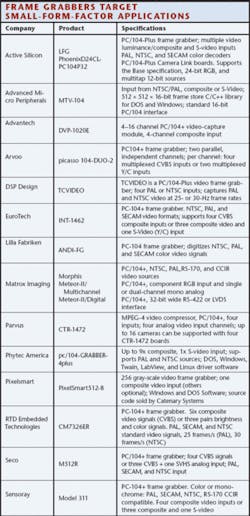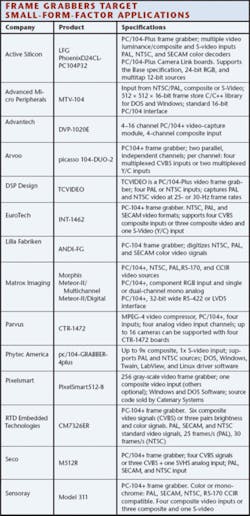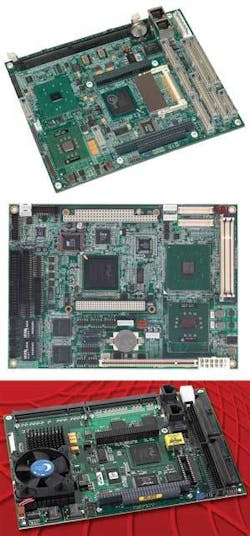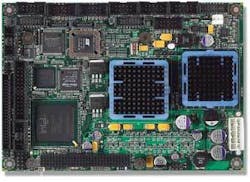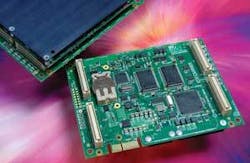Frame grabbers move into embedded applications
Vendors of embedded frame grabbers are looking to support the latest single-board computers with PC/104-format boards.
By Andrew Wilson, Editor
Designers of embedded machine-vision and image-processing systems have several choices when implementing their products. Of course, a number of off-the-shelf boards are available on standard backplanes, such as PCI, that allow image capture, processing, and display functions to be incorporated into PC-based systems. However, for many embedded medical, aerospace/military, and hazardous applications where ruggedness, small size, and low power are critical, designers may be forced into building proprietary solutions.
A number of emerging form factors are now attempting to address this problem with standards that allow developers to create products that can be packaged in small enclosures and openly expanded. While many of these have emerged from well-established standards such as PC/104, others, such as the Embedded Board eXpandable (EBX) standard and the Embedded Platform for Industrial Computing (EPIC), are offered by large board-level OEMs.
Since its introduction more than 15 years ago, the PC/104 form factor has become very popular with embedded-systems designers. Based around the standard PC and PC/AT bus, the approximately 3.5 × 3.7-in. form factor of PC/104 boards eliminates the need for backplanes or card cages by using a self-stacking bus that proves beneficial in rugged embedded applications. Named after the 104 signal contacts on the P1 and P2 bus connectors used on the boards, the PC/104 form factor is specified in 8- and 16-bit versions corresponding to the PC and PC/AT buses, respectively.
Capturing images
With the emergence of the PCI bus, the PC/104 Consortium (www.pc104.org) recognized the need to incorporate the PCI bus onto the PC/104 form factor. Known as PC/104-Plus, this standard uses a third connector to support the PCI bus while allowing the standard to remain compatible with existing PC/104 hardware. And, to allow extra board space for more components and connectors, the PC-104 standard removes the ISA bus from PC/104-Plus while maintaining PCI compatibility.
To date, numerous PC/104 processors, display controllers, Ethernet adapters, and I/O controllers are available from more than 100 vendors. These allow compact, rugged computer systems to be rapidly configured and deployed using only the functions required by the developer. To digitize images, many companies now offer PC/104 and PC/104-Plus products that can be used with off-the-shelf PC cards and other peripherals to build an imaging system (see table on p. 46).
Upon surveying the products now available to capture images using PC/104 boards, several trends are apparent. First, many vendors including Active Silicon and RTD Embedded Technologies have chosen to build frame grabbers that digitize analog broadcast-format signals such as NTSC, PAL, and SECAM. Many of these designs use single IC implementations that are easily incorporated onto the relatively small form factor of the PC/104 board format. While sophisticated external camera timing and triggering may not be a feature of these boards, they do provide a means for embedded-systems designers to digitize analog data.
One of the largest suppliers of PC/104 boards is Arvoo Imaging Products. As well as offering its picasso 104-DUO-2, a PC/104-Plus a frame grabber capable of digitizing four multiplexed CVBS inputs, the company offers six other PC/104-Plus boards, more useful in machine-vision applications. These include the picasso 104-CL, a Camera Link Base-16-compatible board capable of transferring 16-bit data from Camera Link cameras at a maximum data rate of 40 MHz. For older, LVDS-based cameras, the company has also developed the picasso 104-LS, an RS-644 (LVDS) compatible board that can also transfer 16-bit data at a maximum 40 MHz data rate (see Fig. 1).
Embedded SBCs
Despite the numerous PC/104 products and variants now available, the PC/104 Consortium recognized the need for an embedded single-board-computer (SBC) standard. With the goal of offering SBCs that maintain backward compatibility with existing standards such as PC/104, the PC/104 Consortium introduced its EBX standard and a mid-sized version, the EPIC.
Based on a 5.75 × 8.00-in. embedded SBC format, EBX is small enough for embedded applications, yet large enough to contain the functions of a fully embedded computer system containing CPU, memory, mass storage, I/O, display, and serial and parallel ports. Supporting PC/104, PC/104-Plus, and PCI-104 modules, EBX also supports PCMCIA cards. To do this, EBX provides a module stack location as defined by the PC/104, PC/104-Plus, and PCI-104 specifications that accepts PC/104-Plus (PCI and ISA), PCI-104 (PCI), or PC/104 (ISA) expansion modules.
At present, a number of companies offer SBCs in the EBX format. Many of these companies, including Ampro, Advantech, and VersaLogic, offer SBCs that support the PC/104-Plus standard, a range of processors, and I/O interfaces. While Ampro’s LittleBoard 800, for example, is offered with Centrino processors, Gigabit Ethernet, USB 2.0, DDR memory, as well as PC-104-Plus expansion, Advantech also supports the PC-104/Plus standard in its PCM-9584 embedded SBC. Similarly, the design of VersaLogic’s Celeron M-based Cobra SBC offers numerous interfaces including two Ethernet ports, six USB ports, 32 lines of digital I/O, and a CompactFlash socket (see Fig. 2 on p. 45).
Developing this concept further, the EPIC format’s size, at 4.528 × 6.496 in., is midway between the size of the PC/104 stackable format and the EBX’s SBC form factor. Like the EBX, the EPIC allows system developers to add I/O expansion using PC/104, PC/104-Plus, and PCI/104 boards. Both the EBX and EPIC form factors have been embraced by numerous SBC vendors with a range of products supporting numerous processors and interfaces.
Most of the companies that offer EBX SBCs also offer versions in the EPIC form factor. Like their EBX counterparts, these EPIC boards can be configured with a number of different processors with Intel’s Pentium and Celeron families being the most popular choices. American Predator Corporation’s offering, the Gator EPIC, for example, supports Intel LV Pentium M and ULV Celeron M processors and uses Intel’s 855GME chipset to provide a 400MHz front side bus, support for 1 Gbyte of DDR memory and support for PC/104-Plus peripherals (see Fig. 3).
Whither PCI Express?
But what of the venerable PCI Express you ask. With numerous frame-grabber vendors now incorporating the interface into PC-based add-in cards, it was only a matter of time before vendors of embedded OEM products joined the bandwagon. And, after the EPIC standard was introduced in March 2004 as the first mid-sized SBC standard, WinSystems, VersaLogic, Micro/sys, Octagon Systems, and Ampro decided to build on the standard with a logical evolution of the EPIC specification that adds PCI Express expansion capability to the industrial computing platform.
Known as EPIC Express, this new standard builds on the hierarchical, point-to-point interconnect of the PCI Express bus, while incorporating the stacking-style architecture used with EPIC, PC/104, and EBX boards. With the addition of PCI Express, an EPIC board becomes an EPIC Express board. None of the dimensions or I/O zones of an EPIC board change--the parallel PCI bus implemented through the PC/104-Plus connector is simply replaced with a serial PCI Express connector. Similarly, I/O boards that stack on top of EPIC Express are PC/104-size with the PC/104-Plus connector replaced with a PCI Express stacking connector.
While PC-based frame grabbers evolved though ISA, PCI, and PCI-X designs, the latest boards take full advantage of the PCI Express specification. These are offered in a number of configurations using x1, x4 and x8 serial links (see Vision Systems Design, Nov. 2006, p. 95). To bring this standard to the smaller PC/104 footprint boards, the EPIC Express technical committee decided to support four x1 and two x4 links reserving the definition of a single x16 link to handle future video applications.
In the four x1 link (“thin”) configuration, four boards can be stacked using a single 28-pin connector. Because this connector is approximately one-third the size of a PC/104-Plus connector, it allows more components to be placed on a single board. For more bandwidth-intensive applications, four x1 links are supported on the first connector bank and two x4 links, and additional clocks, power, and ground are shared across two additional connectors. This “fat” configuration requires a larger connector with three 28-pin banks. For more detailed information and a copy of the EPIC Express specification, readers are encouraged to visit www.epic-express.org.
First to announce support for the EPIC Express in an SBC design was Ampro with its ReadyBoard 820 SBC. Featuring either Pentium M or Centrino processors with support for stackable PCI Express expansion, the board, announced last November, also supports a Gigabit Ethernet interface, USB 2.0, and SATA interfaces in an EPIC Express form factor SBC (see Fig. 4). By supporting PCI Express with an EPIC Express connector, the board allows numerous PC/104 form factor EPIC Express boards to be added as required.
Already the PCI Express interface is already becoming a de facto standard in the design of PC-based add-in boards. And it is highly likely that it will be adopted by many of the current vendors of PC/104 frame grabbers in the form of EPIC Express add-in boards. However, just as the PCI Express standard was slow to be adopted on PC-based boards, it is likely that it will be some time before EPIC Express add-in frame grabber boards become widely available.
ETX offers alternative to PC/104
Kontron’s ETX form-factor for embedded PC systems was introduced in 2001 as a more elegant solution to medium volume PC-based embedded systems. Now accepted in many industries, the standard is surprisingly still relatively unknown in the machine-vision industry.
ETX is a CPU module with four connectors containing PC connectivity along with a PCI bus that plugs onto a custom designed carrier board (see photo). This carrier board provides all peripheral connectivity and functionality, and, thus, two boards can comprise a complete, compact system. While processor modules can cost less than PC/104-Plus, for embedded systems designers the ETX form-factor solves many problems and often costs less than alternative approaches.
Because the carrier card is custom designed, it allows connector positions to be fixed for the lifetime of the product, making ETX well suited to medical and defense applications. As processor power increases and costs decrease, the plug-on processor module can simply be replaced without affecting anything else in the system--in particular mechanical layouts.
An example of an embedded ETX-based system is the custom two-channel video-capture system developed by Active Silicon. This ETX carrier board has been developed for a volume embedded application and contains two channels of video acquisition; 10 serial ports; USB 2; VGA; Compact Flash; Ethernet; eight-channel ADC; LCD panel driver; and various other I/O connectors.
While a PC/104-Plus implementation would need about a six-board stack to implement such functions, it would also be rather large and expensive. ETX solves these problems, while providing a lower-cost solution. Of course, considering the additional NRE, ETX only works in volumes of a hundred systems per year upward. And, if you need greater performance using PCI Express rather than PCI, the ETX Express standard (www.etx-express.com) could be considered.
Colin Pearce
Managing Director
Active Silicon
www.activesilicon.com
null
